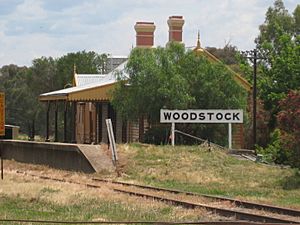Woodstock railway station, New South Wales facts for kids
Quick facts for kids Woodstock railway station |
|
|---|---|

Woodstock station in 2015
|
|
| Location | Blayney–Demondrille line, Woodstock, New South Wales, Australia |
| Owner | Transport Asset Holding Entity |
| Official name: Woodstock Railway Station | |
| Type | state heritage (built) |
| Designated | 2 April 1999 |
| Reference no. | 1290 |
| Type | Railway Platform/ Station |
| Category | Transport - Rail |
| Lua error in Module:Location_map at line 420: attempt to index field 'wikibase' (a nil value). | |
Woodstock railway station is a special old train station in Woodstock, Australia. It used to be part of the Blayney–Demondrille railway line. This station is so important that it was added to the New South Wales State Heritage Register on April 2, 1999. Being "heritage-listed" means it is protected because of its historical value.
Contents
The Story of Woodstock Railway Station
How the Railway Line Started
Back in 1875, people started talking about building the first cross-country railway line in New South Wales. This new line would connect the train lines in the south and west of the state. A surveyor named Wade was asked to find the best path for the tracks between Murrumburrah and Blayney.
Two main routes were considered. One idea was to leave the western line near Blayney, following the Evans Swamp Valley. The other idea was a flatter path further west, between two creeks, passing east of Cowra and then Young, before joining the southern line.
Building the Cross-Country Line
In 1879, another surveyor, Hogg, suggested a different route. He thought the line should start just after Blayney station, go through Carcoar, and pass directly through Young.
The plan to build this cross-country line was approved by the Parliament in April 1881. The first part of the work, from Murrumburrah to Young, began in September 1882. It was supposed to be finished by December 1884, but it finally opened in March 1885.
The rest of the line was built in two parts: from Young to Cowra, and from Cowra to Blayney. Work on these sections began in February 1885. The part from Cowra to Blayney, which included Woodstock, was finished later than planned. This was because materials for a bridge over the Lachlan River at Cowra were delayed.
When Woodstock Station Opened
The section of the railway line that included Woodstock station officially opened on February 13, 1888. Trains served Woodstock and other stations along this line for many years. However, train services to Woodstock stopped around 1987.
What Woodstock Station Looks Like
The Station Building
The Woodstock railway station still has its original building from 1888. It's made of timber, meaning wood, and has a classic design. It's known as a "type 4, 3rd class" station building.
The building has a roof with a pointed shape, covered in metal sheets. It also has two brick chimneys and decorative wooden boards on the ends of the roof. There's a platform awning (a roof-like structure) that sticks out over the platform, supported by metal posts and fancy metal brackets.
Interestingly, the side of the building facing the train platform doesn't have many windows. Most of the windows, which are double-hung sash windows (meaning they slide up and down), are on the side facing the road. Inside, the building has six main rooms, all of which can be reached from the platform.
Other Features at the Station
Besides the main building, you can still see parts of the old train yard. There's a platform made of brick and concrete where people waited for trains. You might also find an old station seat and some original station signs.
In the area where goods were loaded and unloaded, there used to be a special crane with a brick base. There was also a loading bank and what might have been a storage bin for coal. These items show how the station was used for both passengers and moving goods.
Why Woodstock Station is Important
A Glimpse into History
Woodstock railway station is a great example of a timber station building from the late 1800s. It shows how train stations were built during a time when the railway network in New South Wales was growing very quickly. The station building, the loading bank, and the old crane all help us understand how the station worked for passengers and goods back in the 1880s.
A Beautiful Old Building
The station building is a simple but elegant wooden structure. Its veranda awning is a special feature. It stands in a very noticeable spot in the middle of Woodstock town, making it an important part of the town's look.
A Typical Example of its Kind
The Woodstock passenger station is a good example of a "type 4 (third class)" timber railway station. Many stations like this were built in western New South Wales in the late 1800s. It helps us understand the common designs and building styles of that time.

